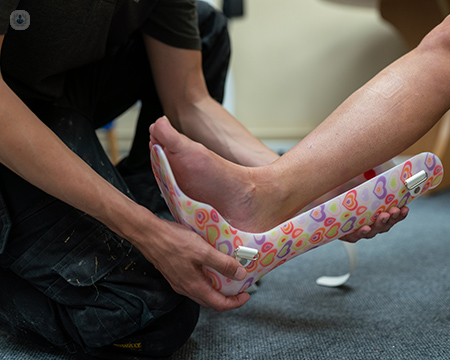An in-depth guide to ankle arthroscopy: Understanding treatment, recommendations, and recovery
Escrito por:Ankle arthroscopy is a minimally invasive surgical procedure that has become increasingly popular for treating a range of ankle-related issues. In this comprehensive guide, renowned consultant orthopaedic foot and ankle surgeon Mr Efstathios Drampalos explores the purpose of ankle arthroscopy, when it is recommended, and what patients can expect during the recovery period.

What does ankle arthroscopy entail?
During this procedure, a specialised instrument known as an arthroscope is employed by your surgeon to examine and address damage within your ankle. The arthroscope, equipped with a camera and light, enables the surgeon to observe the interior of your ankle through a few minor incisions in your skin.
Additional tools necessary for the surgery are also introduced through small incisions. Due to the significantly smaller size of the incisions, typically less than half an inch, ankle arthroscopy is generally less taxing on the body compared to other surgical methods, resulting in reduced stress during the procedure.
What is ankle arthroscopy used to treat?
Ankle arthroscopy is a versatile procedure used to diagnose and treat various conditions affecting the ankle joint. Some common issues addressed through ankle arthroscopy include:
1. Cartilage damage:
- Description: Ankle arthroscopy can be employed to assess and repair or remove damaged cartilage within the ankle joint, restoring smooth joint movement.
- Common conditions: Osteochondral lesions, cartilage defects, and arthritis.
2. Joint inflammation:
- Description: In cases of persistent inflammation within the ankle joint, arthroscopy allows for direct visualization and targeted treatment with debridement of the inflamed tissue.
- Common conditions: Synovitis, gout, rheumatoid arthritis and other inflammatory arthropathies
3. Soft tissue problems:
- Description: Ankle arthroscopy is effective in addressing soft tissue problems ( such as ligament tears or impingements.
- Common Conditions: Persisting pain after severe ankle pain, ligament tears, ankle instability, and ankle impingement syndrome.
4. Bone spurs:
- Description: The procedure can be used to remove bone spurs that cause pain from impingement, relieving pain and improving joint function.
- Common conditions: Ankle Osteoarthritis and prominent Osteophytes, bony prominences, footballer’s ankle
When is ankle arthroscopy recommended?
Diagnostic evaluation: When traditional diagnostic methods (X-rays, MRI) fail to provide a conclusive diagnosis, ankle arthroscopy is recommended for a direct visual examination of the joint. This is common i.e. when pain persists for more than 6 weeks after an ankle sprain.
Therapeutic intervention: When conservative treatments (medication, physical therapy) prove ineffective, or there is a finding from clinical examination and imaging methods (X-rays, MRI, CT scan) that justifies surgery ankle arthroscopy may be recommended for targeted therapeutic intervention.
Treatment planning: Surgeons may recommend ankle arthroscopy as part of a comprehensive treatment plan for conditions like chronic ankle pain, ankle instability, ankle arthritis, cartilage damage or recurrent ankle pain.
What is debridement?
Debridement is a common procedure performed during ankle arthroscopies, and it involves the surgical cleanup of internal structures within your body. In the context of ankle arthroscopy, this entails the removal of damaged tissue or the reshaping of bones to address issues like impingement or arthritis.
What happens during ankle arthroscopy?
During ankle arthroscopy, your surgeon will create small incisions, typically less than half an inch in size, around your ankle to introduce the arthroscope into the joint. Additional minor incisions will be made to facilitate the insertion of other necessary tools for repairing any damage to bones or connective tissues. Once the surgeon gains visibility inside your ankle using the arthroscope, they can proceed with the joint repair.
You will undergo either regional anaesthesia near your ankle to ensure pain-free surgery or general anaesthesia to induce sleep throughout the operation. The duration of most arthroscopies is approximately one hour, although the specific length of your surgery will be determined by your individual requirements.Top of Form
What is the recovery period like?
1. Immediate post-operative period:
- Activities: Patients typically begin walking with the help of crutches immediately after the procedure.
For certain situations, such as the treatment of cartilage damage or ligament surgery, patients may be required to refrain from putting weight on the operated leg for a duration ranging from 2 to 6 weeks. - Monitoring: The surgical site is closely monitored for any signs of infection or complications.
2. First few weeks:
Ankle arthroscopy is typically conducted as an outpatient procedure, allowing you to return home on the day of the surgery. Your healthcare provider or surgeon will discuss the outcomes of the procedure with you and provide instructions on the necessary steps for healing and recovery.
- Precautions: Ice and elevate the ankle, keep the area covered and clean, avoid putting weight on your foot or ankle initially to facilitate healing.
- Activities: Physical therapy is initiated to restore range of motion and strengthen the ankle.
- Take NSAIDS and other medications for pain
- Take showers, not baths and keep the incision covered until the wound heals.
You’ll probably have to wear an ankle splint for a few weeks after your surgery.

3. Mid to long-term recovery:
- Activities: Gradual return to normal activities, including sports and exercise, under the guidance of a healthcare professional.
- Follow-up: Regular follow-up appointments are scheduled to assess progress and address any concerns.
Benefits and Risks
Ankle arthroscopy is one of the least invasive surgeries you can have and the doctor can deal with your problem with very little disruption to your joint tissues. This means you should anticipate:
- A short recovery time — often as little as 2-4 weeks.
- Less pain than with traditional open surgery.
- Minimal blood loss and scarring.
- Decreased risk for complications compared to more invasive open types of surgery.
Potential complications from ankle arthroscopy include:
- Allergic reaction to anaesthesia.
- Nerve damage (numbness or tingling in your foot or ankle)
- Blood clots like deep vein thrombosis (DVT).
- Damage to tissue surrounding your ankle.
- Excessive bleeding or swelling.
- Infections (but with less chances compared to open surgery)
- Need for further surgery (usually open if the issue is not corrected)
Ankle arthroscopy is a valuable tool in the orthopaedic arsenal, providing both diagnostic and therapeutic benefits. By understanding the conditions it treats, the circumstances under which it is recommended, and the expected recovery process, patients can make informed decisions about their ankle health.
If you would like to book a consultation with Mr Drampalos, you can do so today via his Top Doctors profile.


